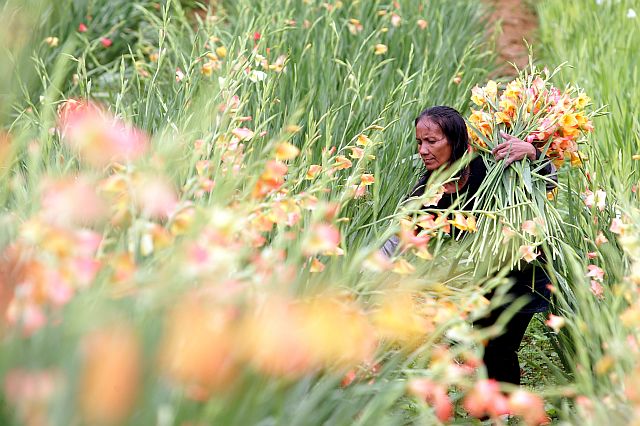
CUT FLOWERS. A farmer in Barangay Sirao, Cebu City’ has started harvesting her flowers in time for next week’s commemoration of “Kalag-kalag,” or All Souls’ Day and Saints’ Day (CDN PHOTO/TONEE DESPOJO).
(Conclusion)
For flower farmer Jonie Bonganoy, the task of harvesting and packing his cut flowers is made easier with the help from his friend Toto Bayawa, 32, who is also the owner of the lot that Bonganoy uses for his flower farm; and his neighbors Elizabeth Noel, 37; and Beverlita Mencede, 35.
They work inside a makeshift tent that has three bamboo beds, where they have laid out the harvested flowers for packing. His wife Elizabeth (same name with the woman neighbor) later joined them in bundling flowers. She also brought lunch for everyone to partake.
“Ganiha ra man gud ming alas sais sa buntag nagsugod og panguha nag bulak. Ingon aron man ang sabot nga ilang kuhaon. Hantod na ni 29 (We started harvesting the flowers at 6 a.m. The buyers are scheduled to pick up the flowers today. This will continue until Oct. 29),” he says.
Despite the hard work, flower farmers like Bonganoy actually look forward to November and consider it the best time of the year since this is when they make good money.
Bonganoy has a total of 40 flower beds both in his friend Bayawa’s farm as well as on an upland area in the same barangay. The harvest went ahead even if the paths in and out of the farm were muddy and slippery due to a heavy downpour from dawn until early morning of Thursday.
Bonganoy says they had no choice but to go around barefoot since they could no longer delay the harvest with a buyer already expected to arrive anytime yesterday.
“Nagtiniil na lang gani mi kay danlog kaayo. Kung mag sapatos or botas pod ka, mutubo man imong sapatos unya mubug-at kay ang mga lapok mamilit. May pag magtiniil nalang kay mas hayahay (We had to go barefoot because it was too slippery. We also couldn’t use boots because the mud would stick on them and it would only make walking more difficult. It’s more comfortable to go barefoot),” he narrates with a hearty and infectious laugh.
Delicate process
But he turns serious as he talks about the delicate process of harvesting when done during a downpour since the flowers could easily get bruised. It’s faster and easier to harvest flowers during the summer but, growing flowers is actually harder during this period since water is scarce during the summer month, he adds.
The price of flowers likewise fluctuates, depending on the quoted price of bulk buyers. For this year, Bonganoy says his flowers are being sold at P80 per bundle, cheaper than last year’s price of P100.
“Nag depende ra man pod mi sa among buyer gud. Mao man ilang ganahan. Di sad mi ganahan makiglalis kay mawad-an mig mamalitay. Maayo unta kong malat-an ni namo ang buwak aron masud-an di man (We have to depend on the buyers. That is the price that they offered. We also don’t want to argue about the price since we might lose our bulk buyers. It’s not as if we can cook our flowers and eat them),” he says.
Bonganoy says they can harvest up to around 3,000 bundles of “puto-puto” during the All Souls’ Day season, which will allow him a gross earning of around P200,000. But his net income, he adds, will just be a fraction of his gross earnings.
Half of the gross earning will go to Bayawa, as the landowner’s 50 percent share. He also has to pay P300 a day for the other flower pickers. He also needs to set aside a portion of the earnings for fertilizer for the next planting season.
For this month’s harvest, Bonganoy says he started planting the flowers around June, exactly four months before the “puto-puto” reached their full bloom in time for the “Kalag-kalag,” or All Souls’ Day, which falls on November 2 but usually celebrated on November 1, which is All Saints’ Day.
On these days, families troop to cemeteries to offer flowers and light candles for the eternal repose of the souls of their departed loved ones.
Disclaimer: The comments uploaded on this site do not necessarily represent or reflect the views of management and owner of Cebudailynews. We reserve the right to exclude comments that we deem to be inconsistent with our editorial standards.
